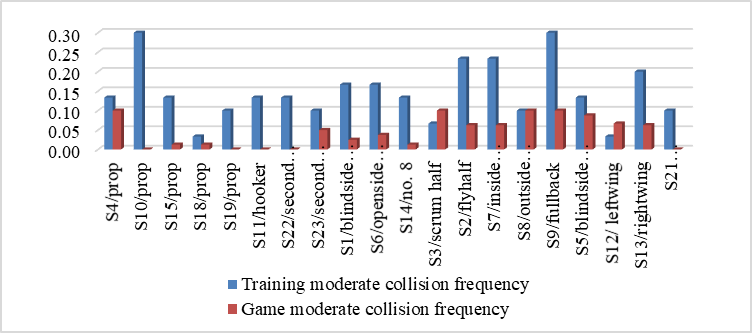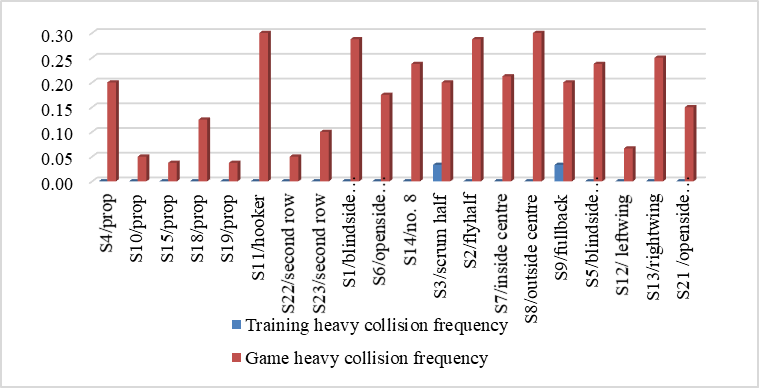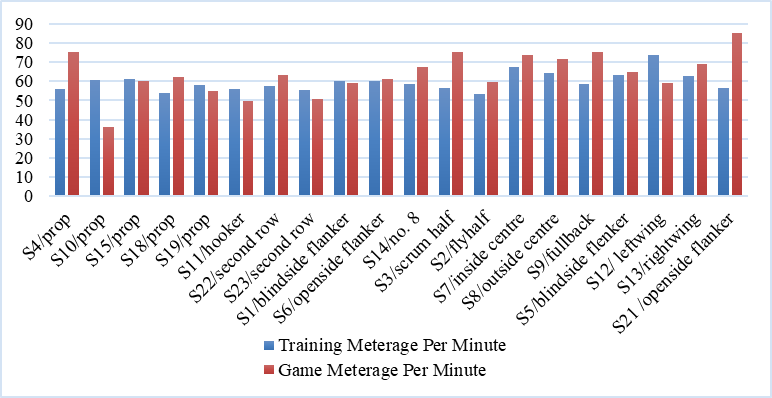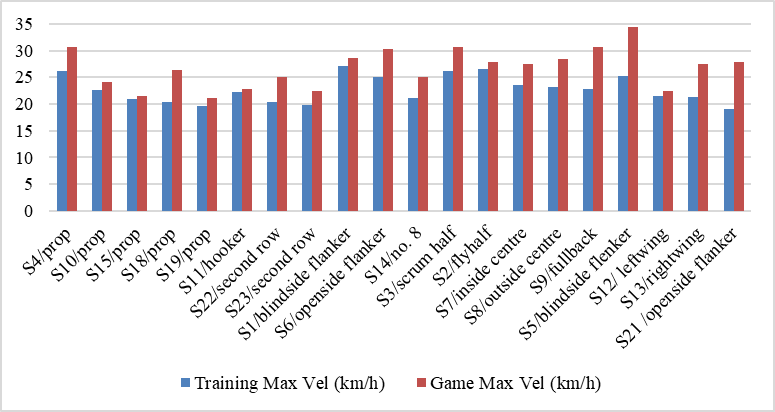Abstract
In this paper, we want to present a parallel between the match effort (in an official match) and the training effort for senior national rugby teams. For monitoring the players, we used the Catapult Sport GPS system. This consists of a GPS which is well placed in a special pocket of each player’s shirt. The pocket is placed in the cervical area to diminish the possibility of injuries as much as possible. With the help of this equipment (together with a dedicated piece of software), there are determined for each player three speed levels (0-15 km/h, 15-21 km/h and above 21 km/h), the distances run, the maximum and minimum pulse values, the maximum speed, the number of accelerations, the distance run at a speed higher than 21 km/h, the total number of collisions and the number of rough collisions (higher than 5G); by subtracting these ones, we get the number of moderate collisions. Also, the equipment’s software can calculate the subjects’ metabolic rates. Having in mind that we are the first possessors of such equipment, we want to use it in order to obtain objective information about each subject, with the purpose of achieving a correlation between the training effort and the match effort for each position and for the entire team.
Keywords: RugbyGPS Catapult Sporteffort monitoringcollision
Introduction
Monitoring represents an important aspect of the player’s evaluation during the match and training sessions alike; through permanent monitoring of the players, we can work out individualised types of training for improving certain deficiencies on the rugby players’ abilities.
The physical demands of rugby vary depending on the playing position.Forwards require more strength and size to enable them contest for the ball while backline players need to be more agile and have a speed to carry the ball past the opposition (Duthie et al., 2003, pp.1).
Monitoring should be done regularly within the preparation program in order to determine whether it improves the athlete’s performance or whether it is has to be changed.
The monitoring results will help make future decisions regarding the corresponding volumes, intensities and training methods for improving future performances.
The monitoring and the conditioning of players not only enables them to play better rugby, but also reduce the risk of injuries (Faigenbaum et al., 1996)
However, when choosing the monitoring methods, one should make sure that these are specific to the game of rugby, namely if they provide information regarding contact, effort zoning, heart rate etc.
The monitoring methods of the training and matches offer us access to objective and diverse information helpful in avoiding the competitors’ fatiguing (Bompa & Claro, 2009, pp. 8-9):
Fatigue affects technical and tactical virtuosity;
It affects the accuracy of passes and shots;
It affects tactical thinking;
A tired player is more exposed to injuries.
Fitness coach should implement a program a structure variation, referred to as periodization, in accordance with this the rugby year may be broken down into these specific areas of emphasis (Rhea & Alderman, 2004).
The “train hard but smart” principle suggests it is no longer enough to work hard, but more importantly to work smart, alternating the energy systems in order to allow replenishing each system’s resources. We support Bompa and Claro’s assertion: “Training is both an art and a science. Improve your science to refine your artistry”.
Problem Statement
Like any sport, rugby has some fundamental components that define it: the technical, physical and psychological features. A good understanding of how they interact leads to performance. Today, most coaches aim to improve physical components, because the technical and tactical ones cannot be sustained at a high level without a high-level physical training. This way, in the last years, there have been invented extremely precise methods for monitoring various parameters characteristic to each athlete’s physical activity. Among the parameters taken into account, we mention: distance run, heart rate, number of accelerations, number of peak efforts, number of collisions, delimitating the effort areas, distances run inside each of these and the athlete’s running speed.
One of the essential aspects of rugby training is the energy system training, together with the periodization of the training session in such a way that restoration, super-compensation and the players’ optimum adaptation to the continually intensifying game tasks are assured. Understanding how the energy systems work leads to performance optimisation by bringing the players to their peak shape at the right time.
Research Questions
Rugby is a fast sport with moments of intense physical activity for taking/keeping possession of the ball, alternating with periods of rest, each of these having different durations.
The game’s characteristics include sprints at maximal and submaximal speeds, quick changes of direction, jumps, tackles and the fight for the ball. These activities force the anaerobic system to produce the required energy, having in mind that it can only produce energy for a short period of time.
Training the lactic acid resistance presumes choosing exercises in such a way that players confront with similar situations as close as possible to those encountered in a match, with durations between 20 and 90 seconds. The exercises used can be circuits, relays or technical and tactical ones. Besides the fact that lactate resistance is trained predominantly during post-puberty, the frequency of training sessions can be 2 or 3 times a week, with a total volume of 5-7 minutes per session and 2-3 minutes of rest between sessions. The best time to do this is at the end of the preparation stage. As the competition season approaches, the training of lactate resistance means more technical and tactical exercises with resting time resembling that in the real games.
Because rugby is a sport with many activities cumulating moments of intense activity and moments of reduced activity or even total rest, the anaerobic pathway of producing energy will be used primarily by the athletes while playing the ball, with certain differences depending on their position, the most intense moments being those of ball possession or those when the ball is in the player’s close surroundings. With all this, the anaerobic pathway of producing energy is of major importance, allowing the optimal ATP recovery and the metabolism and oxidation of the lactic acid produced in the prolonged effort sessions of both high and low intensity. This way, the higher the aerobic capacity or the VO2max, the more the player will have strength in the case of prolonged effort, replenishing much faster their energy resources for a new episode of intense effort (Joyce & Lewindon, 2014).
Purpose of the Study
The purpose of this study is to compare the way in which the athletes act in a real match and a training one in order to establish the necessary intervention priorities. Based on this testing, it can be known whether the player lacks strength or resilience, especially to lactose. This kind of testing will provide information on both the physical preparation of the players and how they get involved in the training matches. Thus, coaches can receive feedback regarding the training programs and special intervention methods.
Research Methods
For monitoring the players in the Romanian national rugby team, we used the Catapult Sport GPS system. The equipment consists of a GPS placed in a special pocket of each player’s special shirt. The pocket is placed in the cervical area to diminish the possibility of injuries as much as possible. With the help of this wireless equipment connected to a laptop with dedicated software, we determined for each player three speed levels (0-15 km/h, 15-21 km/h and above 21 km/h), the distances run, the maximum speed, the number of accelerations, the distance run at a speed higher than 21 km/h and the number of moderate and rough collisions (higher than 5G) in a training/match sequence.
When entering the playing field, we performed a procedure named mapping, which consisted in determining the play area where the measurements were to be done. This way, a GPS carrier surrounds the field on its edges, and thus the data collection will be made only inside this perimeter (avoiding collecting data from the reserve bench).
After connecting the antenna to the laptop and turning on each GPS unit, it is selected the time period to be monitored, and thus the data collection begins.
The collected data were exported into an excel document that we interpreted.
Findings
Of the multitude of collected data, we will comparatively present here the value meterage per minute, the maximum velocity and number of moderate and heavy collisions, mentioning that the training match lasted 30 minutes, while the other one lasted 80 minutes. The graphical representations will illustrate the frequency of collisions per time unit (minute).
Table
The training match lasted 30 minutes. Relating the number of collisions (moderate or heavy alike) to a time unit, it results a certain frequency of collisions (blue bars) represented in Figure


The medium distance run by each player within a minute is presented in Figure


Conclusion
Keeping in mind that heavy collisions may have unpleasant consequences, leading sometimes to temporary incapacity to play, they were avoided in the verification match, where moderate collisions had much bigger share, the players sparing both themselves and their game mates.
Because of the superior motivation in a game (even without a prize) with unknown opponents, the other game parameters also reached superior values in the verification match against the national team of Portugal, compared to a training match in the preseason.
References
- Bompa, T.Claro, F. (2009). Periodization in rugby.
- Joyce, D.Lewindon, D. (2014). High performance training for sports (5th Edition). Human Kinetics.
- Duthie, G.Payne, D.Hooper, S. (2003). Applied physiology and the game analysis of rugby union.. Sports Med, 33(13), 973-991
- Faigenbaum, A D.Kraemer, W J.Cahill, B.Chandler, J.Dziados, J.Elfrink, L D.Forman, E.Gaudiose, M.Micheli, L.Nitka, M.Roberts, S. (1996). Youth resistance training: position statement paper and literature review. Strength cond.. J., 18(6)
- Rhea, M R.Alderman, B L. (2004). A meta- analysis of periodized versus non periodized strength and power training programs,. Res. Q. Exerc. Sport., 75(4), 413-22
Copyright information

This work is licensed under a Creative Commons Attribution-NonCommercial-NoDerivatives 4.0 International License.
About this article
Publication Date
05 March 2018
Article Doi
eBook ISBN
978-1-80296-035-8
Publisher
Future Academy
Volume
36
Print ISBN (optional)
-
Edition Number
1st Edition
Pages
1-484
Subjects
Sports, sport science, physical education, health psychology
Cite this article as:
Baitel, I., Marinescu, G., Stoica, M., & Dreve, A. (2018). Comparative study between the training effort and the match in Romanian rugby. In V. Grigore, M. Stanescu, & M. Paunescu (Eds.), Physical Education, Sport and Kinetotherapy - ICPESK 2017, vol 36. European Proceedings of Social and Behavioural Sciences (pp. 225-231). Future Academy. https://doi.org/10.15405/epsbs.2018.03.30

